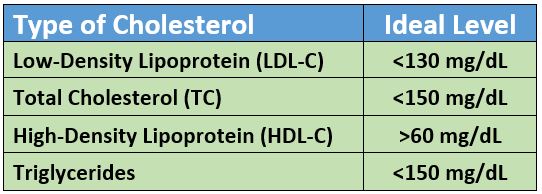Your ideal cholesterol levels depend on your risk of heart disease and stroke. People at risk or who have these problems need to lower their “bad” cholesterol levels. For healthy people without risk, cholesterol levels should at least be:
LDL-C is the “bad” type of cholesterol. It is the number that doctors watch when they are trying to lower your risk of heart disease. The LDL-C level that is right for you depends on your overall risk of heart disease or stroke. If you already have heart disease your doctor may tell you to try to cut your LDL-C number in half. They may also suggest a target number for you.
If you do not have heart disease and your LDL-C is between 70 – 189 mg/dL, your doctor will ask you about other risk factors. These include diabetes, smoking, and high blood pressure. This will help determine your target LDL-C level. Levels below 130 mg/dL are ideal. Levels between 130 mg/dL and 159 mg/dL are borderline high. Levels 160 mg/dL and higher is considered high cholesterol.
Some people should aim for an LDL-C level less than 70 mg/dL. These include people who have:
- A heart attack
- Chest pain called angina
- A stent placed in their coronary arteries
- Bypass surgery
People with coronary artery disease or diabetes should aim for an LDL-C level below 100mg/dL, too. Anyone with an LDL-C of 190 mg/dL or higher should aim to cut the number in half, ideally lower than 100 mg/dL. This is true even if you do not have heart disease yet.
HDL-C is the “good” type of cholesterol. It helps carry away other more harmful types of cholesterol like LDL-C. Levels of HDL-C that are above 60 mg/dL are ideal.
Triglycerides (TG) are another type of fat (lipid) that is measured on a cholesterol test. TGs are important for health, but too much of them in your body can be harmful. When TGs build up, they can lead to weight gain and obesity. Levels of triglycerides below 150 mg/dL are considered ideal. A level of 150 – 199 mg/dL is borderline high, 200 – 499 mg/dL is high, and 500 mg/dL and higher is very high.
When it comes to “bad” cholesterol, lower is always better!


